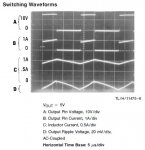I've just been making some boards up with my favourite SM regulator (LM2575-5.0), circuit exactly as data sheet(*), and the power supply works fine.
At low currents the power supply components are silent - at higher currents (220mA or so, so well inside specs) the wire wound inductors start to mechanically "sing" at a high frequency (no, don't know how high - I'd guess a few Khz).
I tried putting some threadlock into the coils of the inductors and letting it dry - it might have made a marginal difference but hardly noticeable to be honest.
They're a respectable make from from Farnell (http://uk.farnell.com/jsp/search/productdetail.jsp?SKU=1864386 - the datasheet is correct but the picture and legend is not as they are 2 pin devices (I told Farnell ages ago but they haven't corrected it yet))
Ideas from the collective? It's not loud, but you can definitely hear it and it's a right PITA
(*)fractionally marginal - maybe I should be using 470uH from Fig 4 of the data sheet, but I wouldn't have thought it would make much/any difference.
At low currents the power supply components are silent - at higher currents (220mA or so, so well inside specs) the wire wound inductors start to mechanically "sing" at a high frequency (no, don't know how high - I'd guess a few Khz).
I tried putting some threadlock into the coils of the inductors and letting it dry - it might have made a marginal difference but hardly noticeable to be honest.
They're a respectable make from from Farnell (http://uk.farnell.com/jsp/search/productdetail.jsp?SKU=1864386 - the datasheet is correct but the picture and legend is not as they are 2 pin devices (I told Farnell ages ago but they haven't corrected it yet))
Ideas from the collective? It's not loud, but you can definitely hear it and it's a right PITA
(*)fractionally marginal - maybe I should be using 470uH from Fig 4 of the data sheet, but I wouldn't have thought it would make much/any difference.



